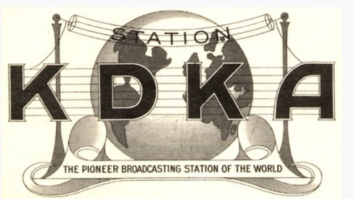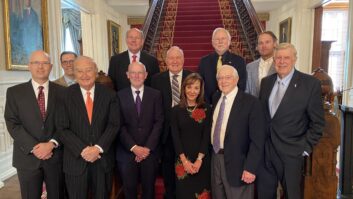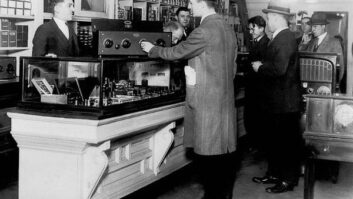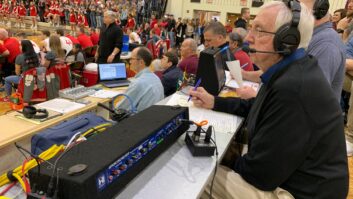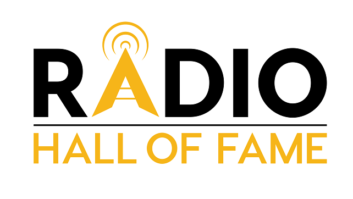
One visitor to the Mic Museum lay down on the floor and said to proprietor Bob Paquette: “I died and went to heaven!”
Anyone who appreciates radio’s history would feel overwhelmed staring at more than 1,000 microphones that date back to the late 1800s. Paquette began his impressive collection in 1950, but the 83-year-old didn’t put it on display until 1970. Along the way, he also picked up some mic enclosures, transformers, preamps, test equipment, spec sheets and related paraphernalia. Other mic-related exhibits include patent applications, catalogs, broadcast periodicals, technical papers and a few transmitters for good measure.
The collection, arranged chronologically, resides in several rooms of Paquette’s business, Select Sound Service in Milwaukee.
THE ACID TEST
Paquette has learned a thing or two over the years.
“One of the very early mics was called the ‘liquid transmitter,’ and it was made by the company later known as AT&T,” says Paquette. “The thing you talked into was a long funnel on a little structure that sat on a base. There was a pin hanging down into a cup of acid and water and, when you spoke, it agitated the pin up and down. So that is what they used in the late 1800s.”
According to Paquette, microphones became more practical between 1920 and 1930, as radio found its way into homes, increasing demand for a device to pick up and amplify human speech.

“At that time, there were about 80 companies that made microphones of one type or another,” he said. “Everyone was building them in their basements, but of course a lot of these companies disappeared. The biggest early names were Shure, Turner, Electro-Voice, RCA and Western Electric.”
In pictures of radio studios from the roaring ’20s, one would likely see the “candlestick” microphone, which was based on the telephone model of the day. There was no “on” or “off” switch. When you hung up the receiver, the device was no longer broadcasting. When it was off the hook, the talent was on the air. Only later was a “press-to-talk” feature added.
“All mics were of a carbon design at first,” says Paquette. “Radio stations and the first recording studios used the same models, which were all omnidirectional. Then Western Electric came out with condenser mics, designed primarily for movie studios. The first dynamic mics were available for radio around 1931, and people liked them because they didn’t need a power supply. You could buy a little three-tube preamp and when the station had a remote broadcast, the engineer would run the audio through a mixer to a phone line to get the signal back to the station.”
In the early 1900s, the general population was not familiar with the principles of electricity, other than what could be read about prisoners being electrocuted in various penitentiaries. Thus, when confronted with a microphone with a wire hanging off of it, the average civilian might head for the hills. This perception would change with time.
A more serious problem lay in that the transmitting gear was fragile, and there was no such thing as compression on the mics. An over-enthusiastic announcer could yell into the mic, blow the tubes and kick the station off the air.
“By the Big Band era of the 1930s, stations used double-button carbon mics,” says Paquette. “They were about two to three inches in diameter and an inch and a half from front to back. The pick-up was spring-loaded within the housing.”
America joined World War II in 1941 and by that time, RCA ribbon mics were available. The physics involved a magnet coupled to a metal frame with a space in the middle for the ribbon to move, providing the modulation. Finally microphones could be bidirectional, which helped with noise cancellation. Instead of picking up audio on all sides of the microphone, these were more selective, allowing audio only from front and back.
One of the first widely used models was the RCA type 44. Later, that company developed the 77 series that culminated in the 77 DX multipattern model, still sought after today. The users of these treasures could select an omnidirectional, bidirectional (figure eight) or unidirectional pattern.

By the 1960s, radio stations began diversifying their programming into more specialized formats such as middle-of-the-road, top 40, country and easy listening. It became evident that different formats might beenhanced with certain microphones. While the 77 D might be perfect for a soft-spoken announcer, a screaming DJ might need something more rugged, such as a dynamic mic. Electro-Voice made a very durable model, the 664, which was heavy and shaped like a thick cigar.The Shure SM5, nicknamed the “Fat Albert,” was a cardioid design that could stand up to high voice levels, as could the SM7, a refinement on the earlier design.
Neumann was, and still is, a German company known for its high-quality condenser microphones. In 1949, it released the U 47, later supplanted by other models such as the U 87. “I have a pair of U 47s,” said Paquette. “I was offered $15,000 for them, but I’m not going to sell.”
SETTING THE TONE
Looking around the museum, you can’t miss the dozens of call letters crowning some mics, stamped or painted on others — WLW, WOR, WABC, WGN, WLS, WTMJ, KWRT, WNJR, WCLO, KYUM, WLDB, WISN, WPAY, WMAQ, KFZ, WRNY, etc. — and numerous iterations of the major radio broadcasters, NBC and CBS. That doesn’t even count the number of loose flags and other station memorabilia such as a set of NBC tone chimes.
Paquette says, “You know, in the early days you could pick your call letters to suit the station. WLS stood for ‘World’s Largest Store’ and WGN stood for ‘World’s Greatest Newspaper.’ I have those mics, and even one from the Moody Bible Institute, which was WMBI. We also have a local mic here from WTMJ, which stood for ‘The Milwaukee Journal.’”
Perhaps the queen of the collection is an enormous diva of a microphone apparatus from Powel Crosley’s Cincinnati-based monster 500 kW station, WLW. In its prime, it could be heard across almost half of the 48 contiguous states. That microphone was one of the instruments bringing entertainment throughout dozens of states.
“I had put on a show in that area where I displayed a bunch of my mics. I met the people from the station and got a tour of WLW … It’s interesting, because that’s only the top half of it. The whole thing is like a long cylinder.”
He continues, “We have it on what they called a 1A stand with a ring. It’s a little mount with a Western Electric carbon mic, and then the call letters are on top.”
He then points to two windows in the front, “Inside, there is an early on-the-air light. They’d tell the announcer to go out by the mic and prepare, and the bottom window would light up and say, ‘PREPARE.’ Then, when it was time, the upper window said ‘BROADCAST.’ Then he knew it was time to talk.”
So how did Paquette come across all of this history? “It just happened over 53 years of collecting,” he replies, sheepishly. Much of it was just luck and being in the right place at the right time. “I put this collection together over 50 years of collecting,” he says. “When I started, it was 1950 — radio stations were trashing a lot of mics from the early days because things were improving technologically.”
As the collection grew, Paquette began to step up his acquisition methods. “I ran ads asking for pre-1940 mics. I’d also go to antique radio swap meets. I’d go to ham radiofests as well. In the summers, I’d cover a 200-mile radius looking for mics. They were often found at rummage prices. Mics that are selling today for over $1,000 could be had back then for $25–$30. The stations would keep buying new ones and I’d get the old ones when they were through with them.”
He adds that he has traded and sold a few mics, but is in general trying to continue building the collection, rather than giving away or selling anything.
And what of the future of the Mic Museum?

“I have offered it for sale for $1 million, but no takers yet. I have a company here, Select Sound Service, with about 12 family members working here and 40 employees in all. There’s no one really interested in maintaining the collection. No one can give tours but me. But my sons want to keep the museum here because people come from all over the world to see it.”
With such a collection, it’s hard not to imagine that Hollywood hasn’t come calling in need of historical accuracy. Turns out, yes, but Paquette has a cautionary tale.
“I had a lot of trouble with Woody Allen,” he says. “I rented him 16 mics for a movie and he wouldn’t return them. He wanted to buy them, but I didn’t want to sell. I couldn’t get them back, so eventually I had to sell them to him. It took me eight years to find replacements.”
It’s not all glory in the mic collecting biz.
HE WROTE THE BOOK
Using his accumulated knowledge, Paquette authored “The History & Evolution of the Microphone,” a tome that weighs six pounds and comprises 840 pages in 8.5 by 11 inches format. There were just 500 copies printed, and it sells for $100 plus $10 shipping, available only through his company at www.sssmilwaukee.com. The first chapters detail the earliest efforts to convert acoustic energy into electrical energy, and the others guide the reader through various broadcast and non-broadcast uses of microphones and related equipment.
While this work covers primarily United States-manufactured products, important designs from international manufacturers are also included.
Other oddities one might see during the museum tour include a big horn-style speaker that was used behind the movie screen for the earliest “talkies.” There are wire recorders, tape recorders, recording lathes and a full replica of the B-17 bomber radio room, circa World War II.
Paquette owns examples of all of the above-mentioned microphones and much more, all housed in his museum. The Mic Museum is open to the public at no charge, but by appointment only. To schedule a tour in Milwaukee, call (414) 645-1672.
Ken Deutsch still carries a Neumann TLM 127 around the house so he can practice his “radio voice.” His wife is not amused.





